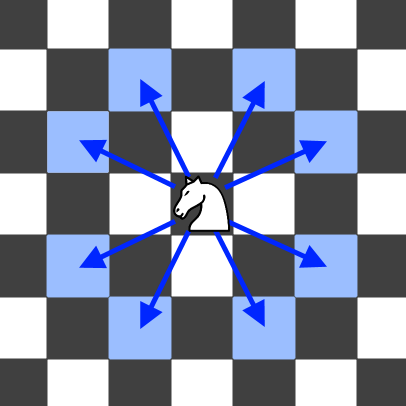原题链接在这里:https://leetcode.com/problems/minimum-knight-moves/
题目:
In an infinite chess board with coordinates from -infinity to +infinity, you have a knight at square [0, 0].
A knight has 8 possible moves it can make, as illustrated below. Each move is two squares in a cardinal direction, then one square in an orthogonal direction.

Return the minimum number of steps needed to move the knight to the square [x, y]. It is guaranteed the answer exists.
Example 1:
Input: x = 2, y = 1 Output: 1 Explanation: [0, 0] → [2, 1]
Example 2:
Input: x = 5, y = 5 Output: 4 Explanation: [0, 0] → [2, 1] → [4, 2] → [3, 4] → [5, 5]
Constraints:
|x| + |y| <= 300
题解:
It is asking the minimum steps to get to (x, y). Thus, use BFS to iterate from (0, 0).
But how to make it faster. Since it is symmatic, we could focus on 1/4 directions.
Make x = |x|, y = |y|. Thus when doing BFS, besides checking it is visited, we also need to check it is within the boundary.
The bounday is >= -1. The reason it the shortest path may need the node on x =-1, y =-1. e.g. shortest path to (1, 1) is (0,0) -> (-1, 2) -> (1, 1).
Time Complexity: O(V+E). V is node count. E is edge count.
Space: O(V).
AC Java:
1 class Solution { 2 int [][] dirs = new int[][]{{-1, -2}, {-1, 2}, {1, -2}, {1, 2}, {-2, -1}, {-2, 1}, {2, -1}, {2, 1}}; 3 4 public int minKnightMoves(int x, int y) { 5 x = Math.abs(x); 6 y = Math.abs(y); 7 8 HashSet<String> visited = new HashSet<>(); 9 LinkedList<int []> que = new LinkedList<>(); 10 que.add(new int[]{0, 0}); 11 visited.add("0,0"); 12 13 int step = 0; 14 while(!que.isEmpty()){ 15 int size = que.size(); 16 while(size-->0){ 17 int [] cur = que.poll(); 18 if(cur[0] == x && cur[1] == y){ 19 return step; 20 } 21 22 for(int [] dir : dirs){ 23 int i = cur[0] + dir[0]; 24 int j = cur[1] + dir[1]; 25 if(!visited.contains(i+","+j) && i>=-1 && j>=-1){ 26 que.add(new int[]{i, j}); 27 visited.add(i+","+j); 28 } 29 } 30 } 31 32 step++; 33 } 34 35 return -1; 36 } 37 }